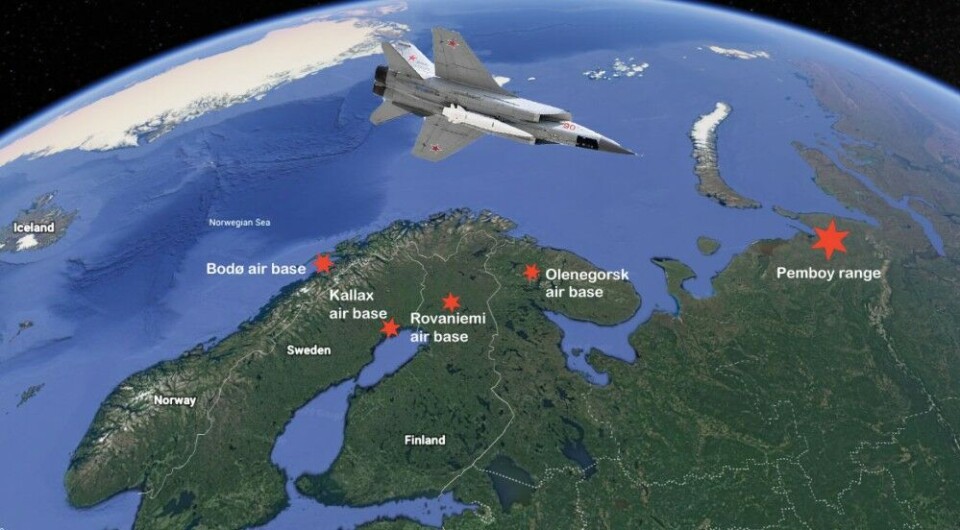
Nuclear-capable air-launched ballistic missile tested over the Barents Sea
The Kinzhal missile was launched from a MiG-31K taking off from Olenegorsk airbase on the Kola Peninsula.
The missile changes the military power-balance in the north due to its range, speed and ability to overcome any known missile defence systems.
Kh-47M2 Kinzhal (NATO name SA-N-9 Gauntlet) is one of the six new strategic nuclear weapons under development in Russia. Several of them were highlighted by Vladimir Putin in his presidential address to the Federal Assembly on March 1, 2018.
Now, the missile is tested and like several of the other new strategic weapons under development by Russia, the test took place in the northwestern part of the country.
“The test took place in mid-November. The missile was launched at a ground target located at the Pemboy training ground from a MiG-31K carrier plane, taking off from Olenegorsk airfield,” a military source said to news agency TASS.
Olenegorsk air base is an hour drive south of Murmansk, while the Pemboy range is about 60 kilometres from Vorkuta, just west of the Ural mountains in the Komi Republic. The missile was likely launched while the aircraft was over the Barents Sea.
Extra range
In principle, the Kinzhal missile is an air-carried version of the Iskander land-based short-range ballistic missile. That said, placing such missile on an aircraft gives it a more dangerous strategic position.
First, the missile could be launched from unpredictable locations because an aircraft moves much faster than a land-based vehicle. Secondly, an aircraft adds extra range before the missile itself is launched.
Unlike cruise missiles launched from an aircraft, the Kinzhal goes ballistic. Like other ballistic missiles launched from silos or submarines, going ballistic via space means hypersonic speed.
The test missile in mid-November reached a speed of 10 Machs another source told TASS.
Kinzhal can carry both conventional and nuclear warheads.
Franz Josef Land
According to a TASS report from July, the Kinzhal has a range of 2.000 kilometres when carried by a MiG-31 and about 3.000 kilometres if carried by a Tu-22M3 long-ranged bomber.
Both the Mig-31 and the Tu-22M3 are based on the Kola Peninsula.
As previously reported by the Barents Observer, the MiG-31 will also serve the new airfield currently under construction at Nagurskoye base at Franz Josef Land.
For Nordic neighbours, the Kinzhal missile will pose a totally new military challenge. In distance from Olenegorsk air base south of Murmansk, Norway’s Bodø air base is 800 kilometres away and within range with good margins.
Bodø is the main airport for Norway’s fleet of F-16 fighter jets.
Kallax air base in Luleå, northern Sweden, is 570 kilometres from Olenegorsk, while Rovaniemi air base in Finnish Lapland is 370 kilometres away. Even Satakunta Air Command at Tampere in southern Finland is within range, located 880 kilometres from Olenegorsk on Russia’s Kola Peninsula.
Securing bastion defense
Deployed at aircraft taking off from the Kola Peninsula, the Kinzhal gives Russia a deterrence measure against any NATO surface warships in the bastion area.
Russia’s bastion area is north of the Greenland, Iceland, and United Kingdom (GIUK) defense line and covers the Norwegian- and Barents Sea. This is the area where Russia will make denial, or anti-access, for NATO ships and aircraft in order to guarantee the survival of the ballistic missile submarines (SSBNs) and by that secure credible nuclear strike deterrence. All of the Northern Fleet’s SSBNs are based in Gadzhiyevo north of Murmansk.
At a speed of Mach 10 within seconds after launch from an airborne MiG-31, the response time in case of conflict is highly limited for Russia’s Nordic neighbours.
The US based Missile Defense Advocacy Alliance said the missile’s performances allows it to overcome “any known United States air or missile defense systems.”
We hope you found this article interesting. Unlike many others, the Barents Observer has no paywall. We want to keep our journalism open to everyone, including to our Russian readers. The Independent Barents Observer is a journalist-owned newspaper. It takes a lot of hard work and money to produce. But, we strongly believe our bilingual reporting makes a difference in the north. We therefore got a small favor to ask; make a small donation to our work.
















